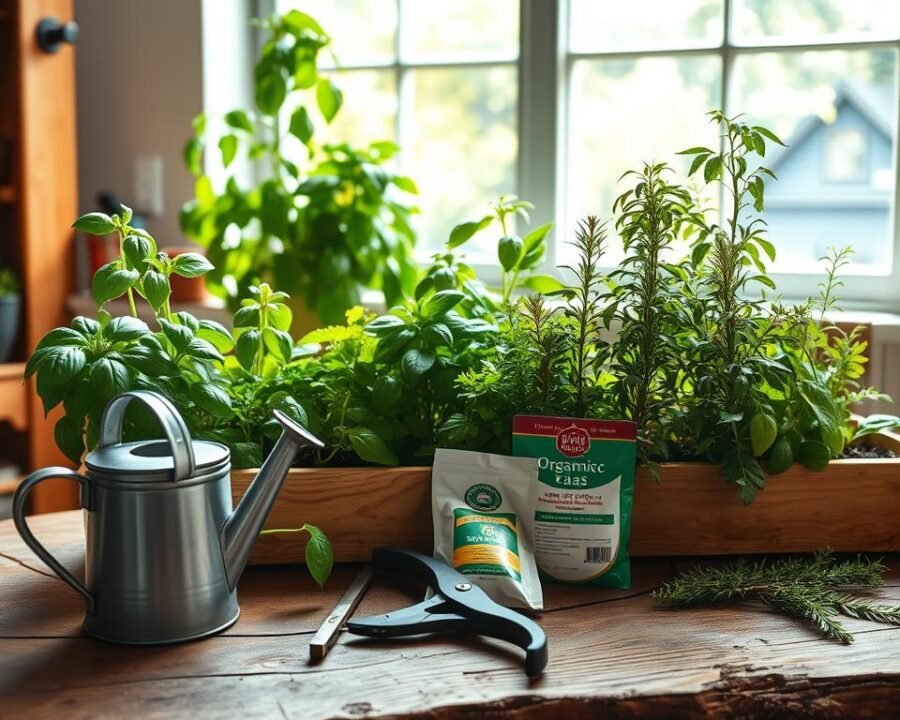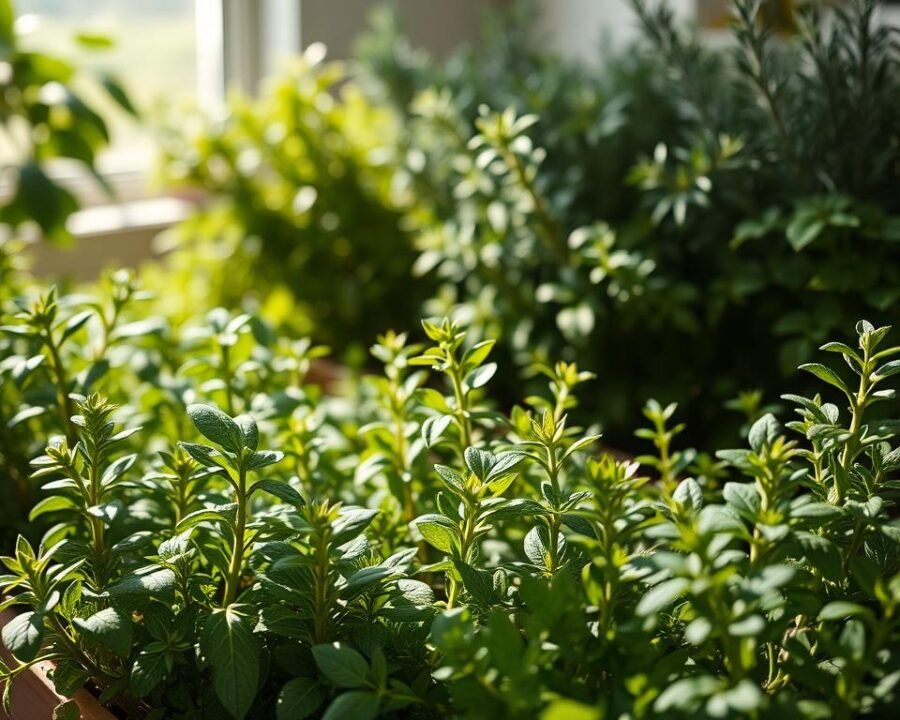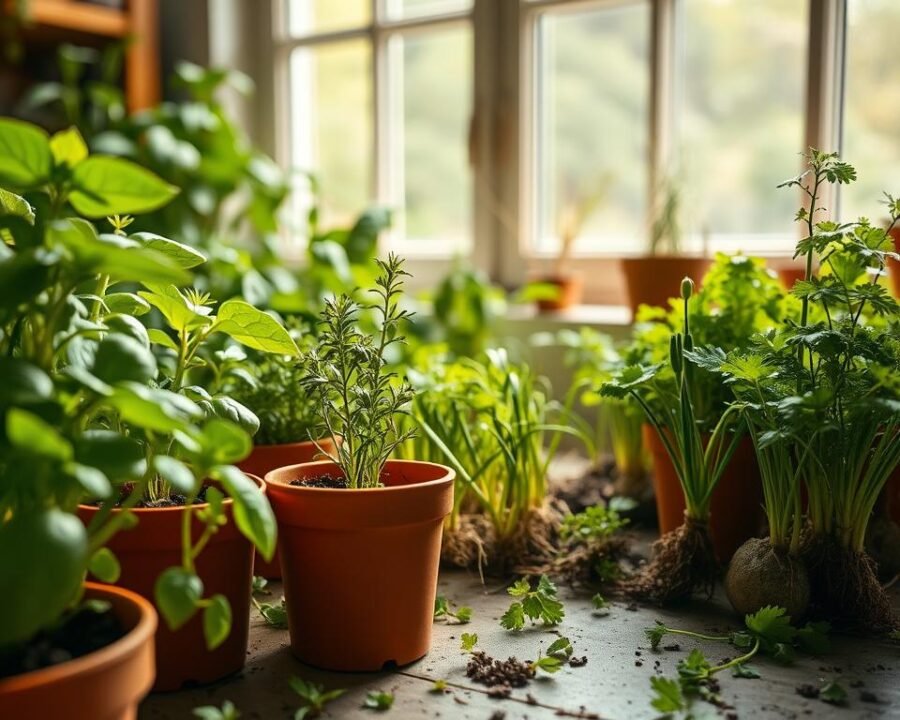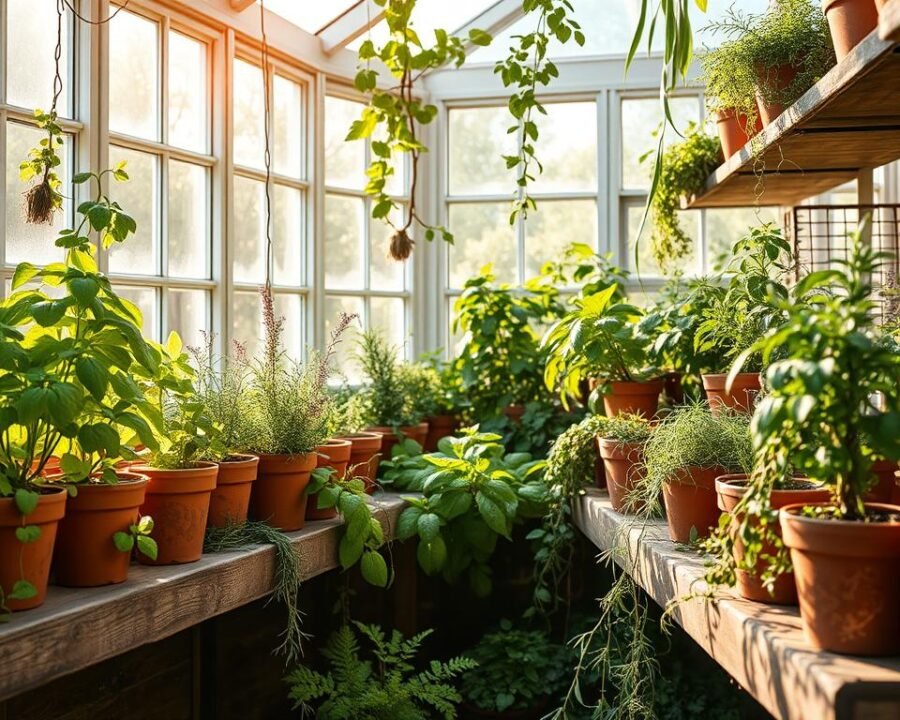There’s something magical about snipping fresh leaves straight from your windowsill. Whether you live in a bustling city apartment or a cozy suburban home, growing plants indoors brings nature’s vibrancy right to your fingertips. No backyard? No problem. With the right choices, anyone can cultivate a thriving green space inside.
Imagine stepping into your kitchen and plucking fragrant basil for pasta or mint for tea—year-round. Indoor gardening isn’t just for experts. Even beginners can enjoy lush, flavorful results with minimal effort. Vermont horticulturist Ann McCullough agrees: “Containers and small spaces work beautifully for many varieties.”
Beyond flavor, these plants add life to your decor and offer therapeutic benefits. From compact setups like the Oslo Tabletop Grow Kit to creative DIY solutions, flexibility is key. USDA zones don’t limit indoor growth, making it accessible no matter where you live.
Key Takeaways
- Fresh flavors are always within reach with year-round indoor growing.
- Perfect for small spaces, containers make gardening simple.
- Many varieties thrive indoors, offering both culinary and decorative perks.
- Expert-approved picks ensure success for all skill levels.
- Therapeutic benefits come with tending to your green companions.
Why Start an Indoor Herb Garden?
Skip the grocery store—harvest herbs daily from home. A small windowsill setup saves money and elevates dishes with unmatched freshness. Store-bought options wilt within days, but living plants thrive for months.
Cost-effectiveness shines when comparing prices. A $3 basil plant yields 10x more than pre-packaged clamshells. Over a year, growing your own can slash herb expenses by 60%.
Nutritional value also wins. Studies show homegrown varieties retain 40% more antioxidants after harvest. Commercial herbs lose potency during transport and storage.
| Factor | Store-Bought | Homegrown |
|---|---|---|
| Shelf Life | 3–7 days | Months (alive) |
| Cost per Ounce | $2–$5 | $0.10–$0.50 |
| Flavor Intensity | Mild | Robust |
Urban gardening is booming—USDA reports a 65% increase in apartment growers since 2020. Vertical planters maximize tight spaces. One Brooklyn resident grew 15 varieties in just 4 square feet.
Beyond practicality, tending greens reduces stress. Horticultural therapy studies note a 30% drop in cortisol levels after 20 minutes of plant care. Varieties like lavender and rosemary even purify air while you sleep.
Myth-busting time: Indoor gardening isn’t fussy. Start with hardy picks like mint or chives. Pair basil with tomatoes for natural pest control—no chemicals needed.
Best Herbs for Beginners: Easy-to-Grow Picks
No green thumb required—these herbs flourish even with occasional neglect. Perfect for first-timers, they reward you with vibrant leaves and bold flavors. We’ve curated four fail-proof options to kickstart your indoor herb journey.
Basil: The Versatile Favorite
Genovese basil shines in pesto, while Thai varieties add spice to stir-fries. Both crave sun (6+ hours daily) and well-draining soil (pH 6.0–7.0). “A south-facing window is ideal,” notes urban gardener Liam Chen.
Watch for aphids—wipe leaves with soapy water weekly. Pair with tomatoes in shared containers; they deter pests naturally.
Mint: Refreshing and Hardy
Peppermint grows vertically, while spearmint spreads horizontally. Containers prevent invasive roots. This plant thrives in partial shade and moist soil. Harvest by pinching stems to encourage bushiness.
Chives: Mild and Low-Maintenance
Snip them like a “crew cut”—they regrow in days. Prefer morning sun and moderate water. Their delicate onion flavor elevates eggs and soups.
Parsley: A Biennial Beauty
Flat-leaf packs more flavor, while curly types garnish beautifully. Sow seeds ¼ inch deep; germination takes 2–4 weeks. Keep soil consistently damp but not soggy.
- Container size: 6–8 inches deep for roots to spread.
- Companions: Rosemary and thyme share similar drainage needs.
- Germination: Basil (5–10 days), mint (10–15 days), chives (7–14 days).
Setting Up Your Indoor Herb Garden
Transforming a corner of your home into a lush, green oasis starts with smart setup choices. Three pillars ensure success: the right container, balanced soil, and adequate light. Nail these, and your plants will reward you with vigorous growth.
Choosing the Right Containers
Terracotta breathes better, but plastic retains moisture longer. Match the material to your herbs’ needs. Mediterranean varieties like rosemary thrive in porous clay, while moisture-loving mint prefers glazed ceramic.
Drainage holes are non-negotiable—root rot kills more plants than neglect. For pots without holes, layer pebbles at the bottom. Self-watering systems work well for busy growers.
| Type | Pros | Cons |
|---|---|---|
| Terracotta | Airflow, prevents overwatering | Heavy, dries out fast |
| Plastic | Lightweight, affordable | Poor drainage risks mold |
| Ceramic | Stylish, retains moisture | Expensive, fragile |
Selecting the Perfect Soil Mix
Not all dirt is equal. Mediterranean herbs grow best in a cactus mix (sandy, pH 6.5). Leafy types like basil need loamy blends with compost. Avoid garden soil—it compacts and harbors pests.
Fertilize monthly with a 5-5-5 NPK ratio for balanced nutrition. Repot annually to refresh nutrients.
Lighting Needs for Thriving Herbs
South-facing windows deliver 6+ hours of sunlight. Supplement with LED grow lights (6500K, 2000 lumens) in darker spaces. Rotate pots weekly for even exposure.
Pro tip: Insulate windows in winter to protect roots from drafts. Hanging planters save space for small apartments.
Essential Care Tips for Indoor Herbs
Healthy, flavorful harvests start with mastering a few essential maintenance habits. Whether you’re nurturing basil or mint, these strategies keep your greenery thriving. Let’s dive into watering, pruning, and pest control—the pillars of indoor success.

Watering Do’s and Don’ts
Overwatering is the top killer of potted plants. Use the finger test: if the top inch of soil feels dry, it’s time to hydrate. *Bottom-watering* (placing pots in a tray) encourages roots to grow downward, while top-watering risks soggy soil.
- Seasonal adjustments: Reduce frequency in winter when growth slows.
- Drainage matters: Always choose pots with holes to prevent root rot.
- Humidity help: Place pebble trays under pots for moisture-loving varieties like mint.
Pruning and Harvesting Techniques
Regular trimming boosts bushier growth. Snip stems just above leaf nodes at a 45-degree angle. For herbs like basil, pinch off flower buds to redirect energy to leaves.
“Harvest no more than ⅓ of the plant at once to avoid shock.”
Managing Pests and Diseases
Spider mites and whiteflies are common invaders. Isolate affected plants immediately. Wipe leaves with neem oil or homemade garlic spray (1 minced garlic clove + 1 quart water).
| Pest | Signs | Organic Fix |
|---|---|---|
| Spider Mites | Webbing on leaves | Spray with diluted soapy water |
| Whiteflies | Tiny white insects | Yellow sticky traps |
Prevent outbreaks by ensuring good air circulation and avoiding overcrowded pots. Quarantine new plants for a week before introducing them to your garden.
Herbs That Love Sunny Windowsills
Bright sunlight streaming through your window isn’t just for houseplants—it’s perfect for growing robust culinary herbs. These Mediterranean natives crave six or more hours of direct sunlight daily, making south-facing windows their ideal home. Unlike shade-tolerant varieties, they develop more intense flavor when basking in ample light.
Rosemary: Aromatic and Drought-Tolerant
This woody perennial thrives in conditions that mimic its native coastal cliffs. Drainage is crucial—use a gritty cactus mix to prevent soggy roots. We recommend two main types:
| Variety | Growth Habit | Best Use |
|---|---|---|
| Upright | Vertical, 2-3 ft tall | Roasting meats |
| Trailing | Cascading, 1 ft tall | Container edges |
For propagation, place cuttings under a humidity dome until roots form. Rotate pots seasonally to ensure even growth as the sun‘s angle changes.
“Rosemary’s essential oils peak when harvested in morning light after the dew dries.”
Thyme: Flavorful and Low-Water
This groundcover herb evolved to survive rocky hillsides. Its tiny leaves conserve moisture, requiring watering only when soil completely dries. Try these adaptations:
- Silver-edged varieties reflect excess light
- Wooly thyme thrives in hottest spots
- Lemon thyme adds citrus notes to dishes
Flavor intensifies when plants experience mild stress—let them dry slightly between waterings. Pair with lavender for a fragrant sunny windowsill duo.
Oregano: Mediterranean Classic
Packed with phytochemicals, this pizza staple offers more than taste. Greek varieties contain 20% more antioxidants than common types. For strongest flavor:
- Harvest before flowering when oils concentrate
- Use leaves dried for sauces, fresh for salads
- Combine with tomatoes in companion planting
Winter warning: Move pots away from drafty windows when temperatures drop below 45°F. These sun lovers still need protection from cold glass.
Transform your harvests with this simple infusion: Combine 1 cup olive oil with ¼ cup packed oregano leaves in a jar. Place on the sunny windowsill for 3 days, then strain. The oil gains herbal complexity perfect for dressings.
Herbs for Partial Shade
Not every windowsill gets full sun, but that doesn’t mean you can’t grow flavorful herbs. East-facing windows or spots with dappled light work perfectly for these adaptable varieties. They’ll thrive with just 3–4 hours of daily sunlight, making them ideal for apartments or rooms with limited exposure.

Lemon Balm: Fragrant and Forgiving
This citrus-scented perennial tolerates low light and bounces back from neglect. Its leaves make calming teas that reduce anxiety—steep 5 fresh leaves in hot water for 10 minutes. To prevent leggy growth, prune stems back by one-third monthly.
Fun fact: Rubbing crushed leaves on skin naturally repels mosquitoes. Pair it with mint in shared containers to save space.
Cilantro: Fast-Growing and Cool-Loving
Unlike sun-worshipping herbs, cilantro bolts (flowers prematurely) in heat. Keep it in temperatures below 75°F and harvest leaves young. Extend your harvest with succession planting—sow new seeds every 3 weeks.
| Bolting Trigger | Prevention Tip |
|---|---|
| High temperatures | Use shade cloth during midday |
| Dry soil | Mulch with coconut coir |
Tarragon: French Cuisine Staple
French tarragon outperforms Russian varieties in flavor, with a sweet anise kick. It needs just 2000–3000 lux of light—measure with a phone app. Boost air circulation by spacing plants 8 inches apart to deter mold.
“Tarragon’s flavor intensifies when dried. Hang bunches upside down in a dark closet for 2 weeks.”
For shadier spots, place pots near reflective surfaces like white walls. These indoor herb garden picks prove that limited light doesn’t limit possibilities.
Herbs with Unique Flavors
Some plants bring more than freshness to your kitchen—they introduce bold, unexpected tastes. These varieties transform ordinary dishes into culinary adventures with their distinctive profiles. Let’s explore three standout options that elevate both flavor and aroma.
Sage: Earthy and Aromatic
This silvery-leafed perennial offers a pine-like flavor with peppery undertones. Beyond seasoning, its leaves have antimicrobial properties—studies show they inhibit foodborne bacteria. For strongest potency:
- Prune stems by ⅓ in spring to prevent woody growth
- Harvest before flowering when oils peak
- Fry briefly (under 350°F) to avoid bitter burnt notes
Warning: Avoid planting near cucumbers—they stunt each other’s growth. Instead, pair with rosemary for a drought-tolerant duo.
Dill: Feathery and Perfect for Pickling
Delicate umbel flowers attract pollinators while seeding generously. Its anise-like taste shines in Scandinavian gravlax sauce (mix chopped dill with mustard and honey). Growth tips:
| Stage | Care Focus |
|---|---|
| Seedlings | Thin to 12″ apart for airflow |
| Flowering | Collect seeds for next batch |
“Dill’s volatile oils dissipate quickly—add it to hot dishes just before serving.”
Bay Laurel: Essential for Soups
This slow-growing tree thrives in bright indirect sun. Its leathery leaves develop complex flavors when dried—store them in airtight jars for 6 months. Try bonsai techniques for compact growth:
- Wire young branches into graceful curves
- Root-prune annually to maintain size
- Mist leaves to replicate Mediterranean humidity
Fresh leaves pack sharper notes, while dried versions lend deeper warmth to stews. Always remove before serving—their tough texture stays intact during cooking.
These herbs prove that flavor isn’t one-dimensional. From sage’s earthy depth to bay’s aromatic punch, they turn meals into memorable experiences. A single plant can redefine your garden’s culinary potential.
Growing Herbs from Seeds vs. Cuttings
Propagation methods can make or break your herb-growing success. Whether sowing seed or rooting stems, each approach suits different varieties. We’ll compare techniques to help you choose the best start for your plants.

Basil exemplifies easy cuttings—snip 4-inch stems below leaf nodes, then root in water. For seeds, parsley needs patience (germinates in 14–28 days), while chives sprout in 7 days. Success rates vary:
| Herb | Seed Success | Cutting Success |
|---|---|---|
| Mint | 60% | 90% |
| Rosemary | 40% | 70% |
| Oregano | 75% | 85% |
No rooting hormone? Try these alternatives:
- Willow water (soak twigs for 48 hours)
- Aloe vera gel (natural auxins)
- Cinnamon powder (antifungal dip)
Hard seeds like lavender need scarification. Rub between sandpaper or soak in warm water overnight. Peat pellets simplify transplanting, but soil blocks prevent root circling. Both work in small space setups.
“Stratify cold-hardy seeds (chives, parsley) in fridge for 2 weeks to mimic winter.”
Ethical cloning matters—always ask permission before taking cuttings from community gardens. Local seed swaps offer rare varieties adapted to your region. Facebook groups like Urban Seed Traders connect growers nationwide.
Transition tender plants gradually during hardening-off. Increase outdoor time by 1 hour daily over 7 days. This prevents shock when moving from pot to garden.
Using Grow Lights for Optimal Growth
Artificial lighting bridges the gap when natural sunlight falls short. Whether you’re battling short winter days or a dim apartment, the right setup ensures your plants thrive year-round. Modern LEDs mimic the sun’s spectrum, offering 12–16 hours of daily exposure without hiking energy bills.
Full-spectrum white lights outperform blurple (red/blue) models by enhancing leaf color and flavor intensity. PAR (Photosynthetic Active Radiation) values matter—aim for 200–400 µmol/m²/s for leafy varieties. Clip-on designs save pot space, while vertical racks maximize small areas.
| Type | Pros | Cons |
|---|---|---|
| Full-Spectrum LED | Energy-efficient, lifespan: 50,000+ hours | Higher upfront cost |
| Blurple LED | Affordable, targets chlorophyll peaks | Unnatural hue, limited spectrum |
Position lights 6–12 inches above foliage, adjusting as plants grow. Use timers to automate cycles—consistent light prevents stress. Symptoms of overexposure include bleached leaves or crispy edges.
- Energy savings: LEDs cost ~$30/year vs. T5 fluorescents at $80.
- UV benefits: Boosts oil production in rosemary but risks leaf burn.
- Rotation tip: Swap plants weekly for even coverage.
“Clip-on LEDs reduced my basil’s legginess by 70% compared to window light alone.”
In winter, supplement dim windowsills with 6500K bulbs. Reflective surfaces (like aluminum foil) amplify output. Remember: more lumens aren’t always better—match intensity to your herbs’ needs.
Harvesting and Using Your Herbs
The moment you snip fresh herbs for your dishes marks the real reward of indoor gardening. Whether garnishing soups or infusing oils, proper techniques ensure peak flavor and longevity. Let’s explore how to maximize every leaf.
Fresh vs. Dried: Which to Choose?
Delicate leaves like basil lose 30% aroma when dried, while woody rosemary intensifies. A University of Florida study found dried oregano contains 26% more carvacrol (its active compound) than fresh.
| Herb | Best Fresh | Best Dried |
|---|---|---|
| Basil | Pesto, salads | Loses vibrancy |
| Oregano | Garnish | Sauces, rubs |
| Thyme | Cocktails | Stews, breads |
“Sun-dried Mediterranean herbs develop concentrated oils that withstand long cooking times.”
Creative Culinary Uses
Herb scissors with 5 blades chiffonade leaves evenly for salads. Try these pairings:
- Dill + salmon + lemon zest
- Sage + brown butter + squash
- Tarragon + chicken + mustard
For winter meals, freeze chopped herbs in olive oil cubes. They’ll keep 6 months and melt directly into pans.
Preserving Herbs for Long-Term Use
Air-drying works best for low-moisture varieties like rosemary. Dehydrators at 95°F retain more color than oven drying. Compare methods:
| Method | Duration | Best For |
|---|---|---|
| Hanging Bundles | 7–14 days | Thyme, oregano |
| Dehydrator | 4–8 hours | Basil, mint |
| Oil Freezing | N/A | Chives, parsley |
For tinctures, use 80-proof vodka and fresh herbs in a 1:2 ratio. Steep 6 weeks, shaking weekly. Your garden’s bounty can enhance every meal, even in colder months.
Common Mistakes to Avoid
Even seasoned gardeners can stumble when nurturing herbs indoors—here’s how to sidestep common pitfalls. Small oversights in watering, light, or soil can compound quickly. We’ll highlight key errors and their simple fixes.
Overwatering tops the list. Mediterranean varieties like rosemary and thyme crave dry spells between drinks. “Soggy soil suffocates roots within days,” warns the Urban Plant Clinic. Check moisture by inserting a finger—if soil clings, wait.
Leggy stems signal inadequate sunlight. Stretched-out basil or mint needs 6+ hours of direct light. Rotate plants weekly or supplement with grow lights. South-facing windows work best for sun-lovers.
- Fertilizer burn: Yellow leaf edges mean excess nutrients. Flush soil with water and halve dosage.
- Temperature swings: Drafty windows shock tender roots. Keep thermostats above 60°F.
- Overcrowding: Allow 6-8 inches between pots for airflow.
“Root rot shows as black, mushy roots during repotting. Trim affected areas and replant in fresh, well-draining mix.”
Ignoring pH causes nutrient lockout. Most herbs thrive at 6.0-7.0. Test kits cost under $10—adjust with lime (raise) or sulfur (lower). Hard water escalates alkalinity; use filtered or rainwater.
Skip hardening-off, and transplants may wilt. Gradually acclimate plants to new conditions over 7 days. Start with 1 hour outdoors, increasing daily.
New additions can harbor pests. Isolate incoming plants for 10 days. Inspect undersides of leaves for hitchhikers like spider mites.
Unlabeled seedlings become guessing games. Tag pots with sowing dates and varieties. Chives and grass look identical as sprouts!
Conclusion: Start Your Indoor Herb Garden Today
Fresh flavors and greenery are just a windowsill away. With just a little care, your kitchen can become a thriving hub of homegrown goodness year-round.
Begin with easy-to-grow herbs like basil or mint—they require minimal investment but deliver maximum reward. A sunny spot, well-draining soil, and a small pot are all you need to start indoor gardening.
Ready to level up? Download our printable care checklist or join our 30-day community challenge. Share your progress and swap tips with fellow growers.
Every dish tastes better with just-picked ingredients. Your indoor herb garden journey begins now—one snip at a time.
